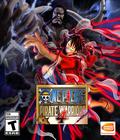
Genre : Racing
Publisher: Nintendo
Developer: Nintendo
Release Date: November 17, 2003
Buy 'MARIO KART: Double Dash': GameCube
 Mario Kart originally appeared on the Super Nintendo in 1992 and offered fast and addictive cart style racing featuring eight characters from the classic Mario universe. A single player could race against the clock or in a Gran Prix mode, a race for points over 5 courses. The tracks were littered with obstacles as well as power-up items, such as green shells, that could be used to blast an opponent, or mushrooms, that gave a quick boost in speed. The multiplayer element offered three choices: a one on one race, a two player Gran Prix, or the legendary battle mode. The battle mode was very simple and only allowed for two players, but was extremely fun. Each player started with three balloons surrounding his cart which popped if hit by a shell or other item. The last player with balloons won. In 1996 came a new Mario Kart, aptly named Mario Kart 64 for the Nintendo 64. It refined the gameplay techniques introduced in Super Mario Kart, while adding suitably updated graphics and new courses. A full 11 years after the release of the original Super Mario Kart comes Mario Kart: Double Dash for Nintendo's latest platform, the GameCube.
Mario Kart originally appeared on the Super Nintendo in 1992 and offered fast and addictive cart style racing featuring eight characters from the classic Mario universe. A single player could race against the clock or in a Gran Prix mode, a race for points over 5 courses. The tracks were littered with obstacles as well as power-up items, such as green shells, that could be used to blast an opponent, or mushrooms, that gave a quick boost in speed. The multiplayer element offered three choices: a one on one race, a two player Gran Prix, or the legendary battle mode. The battle mode was very simple and only allowed for two players, but was extremely fun. Each player started with three balloons surrounding his cart which popped if hit by a shell or other item. The last player with balloons won. In 1996 came a new Mario Kart, aptly named Mario Kart 64 for the Nintendo 64. It refined the gameplay techniques introduced in Super Mario Kart, while adding suitably updated graphics and new courses. A full 11 years after the release of the original Super Mario Kart comes Mario Kart: Double Dash for Nintendo's latest platform, the GameCube.
Double Dash retains most of the gameplay techniques of the original SNES game, which are pretty standard to the cart racing genre. This means often oversized characters are placed in small go-carts that boast decent acceleration, but low top speeds. The mainstay of cart racing is the power slide. The power sliding technique introduced in the SNES version was vital to winning a race, as it allowed you to enter into a turn at full speed, yet still execute a sharp turn without losing speed. This technique was improved in the 64 version in that if you properly waggled the control stick, essentially counter-steering and then re-tightening the turn several times in quick succession, you could gain a mini-turbo boost enabling you to shoot out of a turn at really high speeds. This technique is critical for shaving seconds off your lap time and beating out your opponents, and even new players to the Mario Kart world will soon find themselves power sliding around every available corner.
The greatest change returning players will notice is that now instead of picking a single character to race as, each cart features two characters. The character in front drives while the one in back is in charge of throwing items. At any point during a race, a quick tap of the z-button will cause the characters to swap roles. There are initially 16 characters to choose from, featuring the classic heroes and villains Mario, Luigi, Peach, Donkey Kong, Bowser and Koopa Troopa, as well as some of the more esoteric characters, such as Waluigi and Birdo (an interesting note is that the game manual specifically refers to Birdo as a 'she'). The characters fall into three size classes, light, medium, and heavy, each with a corresponding cart class. The light carts offer fast acceleration and handle well, while the heavy carts offer high top speeds but wide turning arcs, and the medium carts offer a nice balance. The cart selected has to fit the largest member of the team, meaning that if you want a quick and nimble light car, you must choose two light characters. While picking two characters offers some fun combinations, such as Bowser/Peach or the metaphysical Mario/baby Mario combo, switching between characters during a race doesn't really affect the handling or speed of the cart meaning the most important considerations are which cart the combo will allow you too pick as well as what specialty power-ups are available.
Also retuning in Double Dash are most of the power-up items found in the previous games. The items range from missile type weapons that can be shot at other racers, appropriately shells in the Mario universe, to weapons that slip up racers if ran into, such as banana peels or fake power-ups. Some of the more powerful weapons include the invincibility star, which allows a player to quickly bash through other racers, and the lightning bolt, which shrinks the other characters and reduces their top speed. New to Double Dash, as previously mentioned, are each character's specialty items. Every pair in the game features a powerful, and often humorous, special item, such as Donkey Kong's oversized banana peel that splits into three smaller peels when hit, or baby Mario's pet Bow Chow which quickly pulls the toddler up the course while chomping away at rivals. While there are many power-ups available, the game balances them out during a race by giving the more powerful items to the players lagging behind in the field. This means that if you're in first or second place you will rarely receive any item other than a green shell or banana peel. However, while in past Mario Karts being in seventh or eight place almost guaranteed a lightning bolt or star which could very quickly bring you back into contention, Double Dash more often then not doles out the specialty items which are not as useful in aiding a quick surge back to the front of the pack. Also, you can no longer hold an item behind you as in Mario Kart 64 to shield from incoming fire. Instead, a small icon shows when an incoming shell is approaching, and you must time the release appropriately. While sometimes spotty, with practice you can come to reliably shoot down incoming fire.
While the single player aspect of the game is sufficiently fun, it's not too difficult. Though there are no explicit difficulty settings, the competition does heat up as you move from the lighter 50cc engine setting up to 100cc and 150cc settings. Fortunately, Double Dash offers the same multiplayer mayhem as its predecessors, with some new twists. Because there are two characters per cart, the racing multiplayer modes can now be played co-operatively, with one player driving and the other controlling the weapons as well as shifting his or her weight during a power slide. While this is entertaining, the true meat of the multiplayer is in the battle mode. With a similar three strikes your out policy, the standard battle mode is a free for all between 4 players, or 8 via LAN, or some combination of co-op and singly controlled carts. Because you can no longer hold an item such as a banana peel or shell behind you as a shield by holding the trigger, multiplayer battles are often quicker and more intense than Mario Kart 64. Also available is a 'Shine Thief' mode, where the winner is determined by whoever can hold the shine coin the longest, and a Bob-omb blast mode, where the only available weapon is Bob the bomb. While at least as entertaining as the previous games, the multiplayer levels seem quite uninspired, though this is somewhat alleviated by a couple unlockable levels.
Moving to the GameCube has also netted the Mario Kart franchise the expected boost in presentation. The graphics in the series has come a long way since its humble origins on the SNES. The characters and courses are all beautifully rendered as 3-D models in bright, cartoony colors, with a few lackluster exceptions. The animations for each character are well thought out and executed as well. When swapping positions, characters seamlessly (and acrobatically) swing around each other, while sometimes a player nearly falls of a cart as the result of a collision and is comically dragged behind, holding on for dear life. Also, even with most of the racers on the screen shooting shells and dropping peels with reckless abandon, the frame rate never slows down. The audio also follows suit, featuring the sounds you would expect from a game of this sort. Each character also has various catch phrases that they shout out after successfully hitting an opponent or after running into an obstacle. The courses also have unique musical themes, which are appropriately campy without being annoying or overbearing.
On the whole, Mario Kart Double Dash is what you might expect as the series moves from the N64 to the 'Cube, however, that isn't to say it's what you might have hoped. There are a few flaws that will keep it from becoming an excellent game, especially to returning fans. One is that the ability to perform a short hop at the beginning of a power slide has been removed. This hop allowed for the player to cut small corners such as over gaps in the frozen lake level, or over patches of mud or grass in many other levels. Also a very skilled player could sometimes jump over an incoming shell, a valuable skill in the multiplayer mode. Presumably, the jumping was removed because on some stages, there was the potential for a gross misuse of this skill in finding shortcuts through a course (my personal best time of 22 seconds for a 'full' 3 laps on Wario Stadium comes to mind). Also lost is the ability to avoid slipping over a banana peel by taping the brake and whistling, as well as the ability to gain a speed boost by drafting an opponent. Along with this, previous versions allotted a few retries that could be used to redo a course during a Gran Prix. The removal of this is often frustrating, as a stellar performance on the first three courses can be nixed by an ill timed lightning bolt in the final round. Arguably, many of the casual gamers may not be concerned by these issues, but a hardcore fan may find them self returning to play a previous version of the game.
All in all, Mario and friends have lead successful careers as go-cart racers spanning 11 years and four platforms (don't forget the GBA versions). The gameplay is fast and lighthearted, suitable to both younger players looking for an age appropriate game as well as older gamers seeking a refreshing break from some of the more intense games currently on the market. While its sad to say that the two character carts in Double Dash is more of a gimmick than a significant gameplay enhancement to the Mario Kart franchise, the game is certainly entertaining in its own right, though a little more polish and refinement could have lead to a spectacular game, instead of a pretty good one.
Score : 8.0/10





































